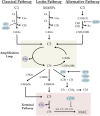Structural and molecular changes in the aging choroid: implications for age-related macular degeneration
- PMID: 27716746
- PMCID: PMC5233940
- DOI: 10.1038/eye.2016.216
Structural and molecular changes in the aging choroid: implications for age-related macular degeneration
Abstract
Age-related macular degeneration (AMD) is a devastating disease-causing vision loss in millions of people around the world. In advanced stages of disease, death of photoreceptor cells, retinal pigment epithelial cells, and choroidal endothelial cells (CECs) are common. Loss of endothelial cells of the choriocapillaris is one of the earliest detectable events in AMD, and, because the outer retina relies on the choriocapillaris for metabolic support, this loss may be the trigger for progression to more advanced stages. Here we highlight evidence for loss of CECs, including changes to vascular density within the choriocapillaris, altered abundance of CEC markers, and changes to overall thickness of the choroid. Furthermore, we review the key components and functions of the choroid, as well as Bruch's membrane, both of which are vital for healthy vision. We discuss changes to the structure and molecular composition of these tissues, many of which develop with age and may contribute to AMD pathogenesis. For example, a crucial event that occurs in the aging choriocapillaris is accumulation of the membrane attack complex, which may result in complement-mediated CEC lysis, and may be a primary cause for AMD-associated choriocapillaris degeneration. The actions of elevated monomeric C-reactive protein in the choriocapillaris in at-risk individuals may also contribute to the inflammatory environment in the choroid and promote disease progression. Finally, we discuss the progress that has been made in the development of AMD therapies, with a focus on cell replacement.
Figures







References
-
- Friedman DS, O'Colmain BJ, Muñoz B, Tomany SC, McCarty C, de Jong PTVM et al. Prevalence of age-related macular degeneration in the United States. Arch Ophthalmol 2004; 122(4): 564–572. - PubMed
-
- Wong WL, Su X, Li X, Cheung CMG, Klein R, Cheng C-Y et al. Global prevalence of age-related macular degeneration and disease burden projection for 2020 and 2040: a systematic review and meta-analysis. Lancet Global Health 2014; 2(2): 106–116. - PubMed
-
- Folk JC, Stone EM. Ranibizumab therapy for neovascular age-related macular degeneration. N Engl J Med 2010; 363(17): 1648–1655. - PubMed
-
- Wangsa-Wirawan ND, Linsenmeier RA. Retinal oxygen: fundamental and clinical aspects. Arch Ophthalmol 2003; 121(4): 547–557. - PubMed
-
- Feeney-Burns L, Burns RP, Gao C-L. Age-related macular changes in humans over 90 years old. Am J Ophthalmol 1990; 109(3): 265–278. - PubMed
Publication types
MeSH terms
Grants and funding
LinkOut - more resources
Full Text Sources
Other Literature Sources
Medical
Research Materials

